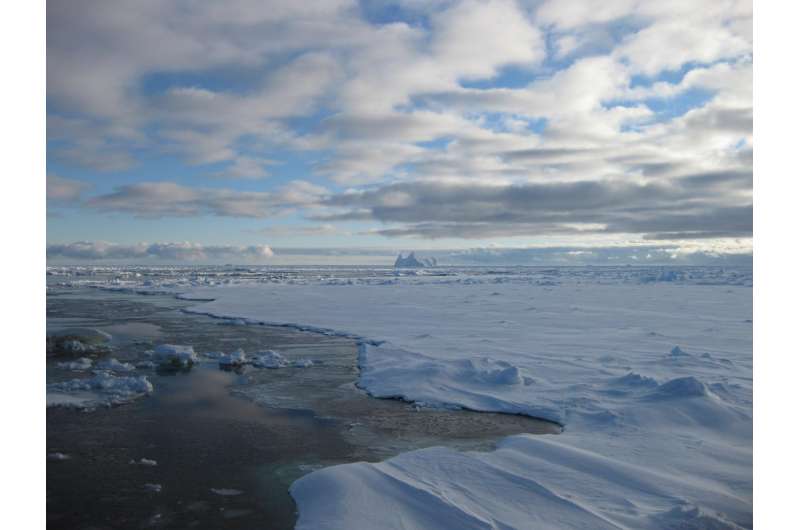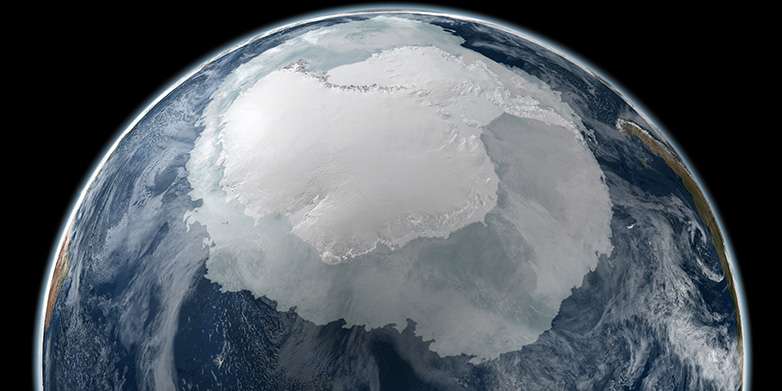September 1, 2016 report
Freshening of Southern Ocean linked to moving sea ice

(Phys.org)—A team of researchers from Switzerland and Germany has found evidence that suggests the reason that the Southern Ocean has become less salty over the past few decades is because sea ice has been moving differently. In their paper published in the journal Nature, the team describes how they used satellite data to create models to explain the changes in ocean salinity just north of Antarctica. Ted Maksym with Woods Hole Oceanographic Institution offers a News & Views piece on the work done by the team and suggests areas for further study.
Scientists have known for some time that the waters of the Southern Ocean have become fresher over the past several decades, but have not known the cause. Some have suggested it was due to changes in precipitation or an increase in meltwater from Antarctic glaciers—but neither argument has held up under scrutiny. Finding the reason is more than just for curiosity's sake; the annual freezing/melting cycle in the Southern Ocean is a major part of the ocean current system—disruptions could cause serious problems in many other parts of the world. To better understand what may be going on, the researchers collected and studied satellite data from the period 1982 through 2008. They also looked at ice reconstruction models built by others over time using observational data. They then used what they had learned to create models of their own. Their model showed that the increased freshness was due to sea ice being driven northward, primarily by wind, before melting. They tested their model against the real data and found they matched, suggested their model was accurate.
When ocean water freezes, most of its salt is forced back into the sea, creating a mass of very cold, dense water—that water sinks to the bottom and then slowly makes its way north. Over time, it warms, causing it to rise and then eventually to move back down south. The net result is a constant circular current that moves carbon dioxide and nutrients that are consumed by a multitude of ocean dwellers. Scientists are worried that changes to salinity levels might somehow impact this cycle.
Unfortunately, the models the team created were unable to offer any additional clues as to why the winds have changed over the past few decades—that will be the focus of future research efforts.

More information: F. Alexander Haumann et al. Sea-ice transport driving Southern Ocean salinity and its recent trends, Nature (2016). DOI: 10.1038/nature19101
Abstract
Recent salinity changes in the Southern Ocean are among the most prominent signals of climate change in the global ocean, yet their underlying causes have not been firmly established. Here we propose that trends in the northward transport of Antarctic sea ice are a major contributor to these changes. Using satellite observations supplemented by sea-ice reconstructions, we estimate that wind-driven northward freshwater transport by sea ice increased by 20 ± 10 per cent between 1982 and 2008. The strongest and most robust increase occurred in the Pacific sector, coinciding with the largest observed salinity changes. We estimate that the additional freshwater for the entire northern sea-ice edge entails a freshening rate of −0.02 ± 0.01 grams per kilogram per decade in the surface and intermediate waters of the open ocean, similar to the observed freshening. The enhanced rejection of salt near the coast of Antarctica associated with stronger sea-ice export counteracts the freshening of both continental shelf and newly formed bottom waters6 due to increases in glacial meltwater12. Although the data sources underlying our results have substantial uncertainties, regional analyses and independent data from an atmospheric reanalysis support our conclusions. Our finding that northward sea-ice freshwater transport is also a key determinant of the mean salinity distribution in the Southern Ocean further underpins the importance of the sea-ice-induced freshwater flux. Through its influence on the density structure of the ocean, this process has critical consequences for the global climate by affecting the exchange of heat, carbon and nutrients between the deep ocean and surface waters.
Journal information: Nature
© 2016 Phys.org




















